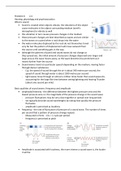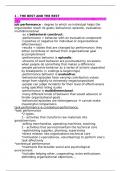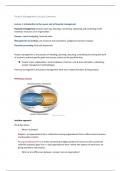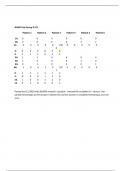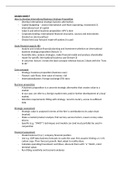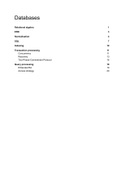Problem 8 2.4
Hearing: physiology and psychoacoustics
What is sound
• Sound is created when objects vibrate, the vibrations of this object
cause molecules in the object surrounding medium (earth’s
atmosphere) to vibrate as well
• this vibration in turn causes pressure changes in the medium
• these pressure changes are best described as waves and are similar
to the waves on a pond when a rock drops into the water
• the water molecules displaced by the rock do not themselves travel
very far but the pattern of displacement will move outward from
the source until something gets in the way
• although the patterns of pond and sound waves do not change as
they spread out, the initial amount of pressure changes dispersed over larger and
large area as the wave moves away, so the wave becomes less prominent as it
moves further from the source
• Sound waves travel at a particular speech depending on the medium, moving faster
through denser substances
- E.g. the speed of sound through the air is about 340 metres per second, the
speed of sound through water is about 1500 metres per second
- light waves move through air almost a million times faster than sound waves do,
accounting for the large like time between seeing lightning and hearing Thunder
(about one second per mile)
Basic qualities of sound waves: frequency and amplitude
• amplitude/intensity - the difference between the highest-pressure area and the
lowest pressure area i.e. the magnitude of the pressure change in the sound wave
- pressure fluctuations may be very close together or spread over long periods
- we typically describe sound wavelengths by noting how quickly the pressure
fluctuates
- amplitude is perceived as loudness
• frequency - the rate of fluctuation of pressure of a sound wave. The number of times
per second that a pattern of pressure change repeats
- Measured in Hertz - 1 hz = 1 cycle per period
- frequency is perceived as pitch
• Amplitude is associated with loudness, the more intense a sound wave is, the louder
it will be
, • Frequency is associated with pitch, low frequency sounds
corresponds to low pitches, and high frequency sounds correspond
to high pitches
• Human hearing uses a limited range of frequencies present in
environmental sounds
- The ratio between the faintest sound humans can detect and the
loudest sound they can detect without damaging their ears is
more than 1-1million
• Sound levels are measured on a logarithmic scale using units called
decibels (dB)
- Decibels define the difference between two sounds in terms of the ration
between sound pressures
- Each 10:1 sound pressure ration is equal to 20 decibels (dB)
- So 100:1 ratio is equal to 40 decibels
• dB = 20 log (p/p0)
Sine Waves and complex sounds
• sine wave – pure tone. All sounds can be described as a
combination of sine waves
• complex sounds are best described in a spectrum that show how
much energy is present at multiple frequencies
• sounds with harmonic spectra are typically caused by a simple
vibrating source
- e.g. a string of a guitar or the reed of a saxophone
- each frequency component in such a sound is called a
“harmonic”
• fundamental frequency – the first harmonic which is the lowest-
frequency component of the sound
- all other harmonics have frequencies that are integer multiples of
the fundamental
• the properties of sound sources determine the spectral shapes of
sounds; these shapes can help us identify sound sources
• timbre (“tamber”) – the psychological sensation by which a listener
can judge that two sounds with the same loudness and pitch are
dissimilar
- timbre quality is conveyed harmonics and other high frequencies
, Basic structure of the mammalian auditory system
Outer ear
• outer ear – the external sound-gathering portion of the ear, consisting of the pinna
and the ear canal
• sounds are first collected from the environment by the pinna and then funnelled by
this structure through the ear canal into the head
• pinna – the outer, funnel-like part of the ear
• ear canal – the canal that conducts sound vibrations from the pinna to the tympanic
membrane and prevents damage to the tympanic membrane
- extends about 25 mm into the head
- the length and shape enhance sound frequencies between about 2000 and
6000hz
• tympanic membrane – the eardrum. A thin sheet of skin at the end of the outer ear
canal which vibrates in response to sound
- border between the outer ear and middle ear
Middle ear
• middle ear – an air-filled chamber containing the middle bones, or ossicles. It
conveys and amplifies vibration from the tympanic membrane to the oval window
• ossicles – any of the 3 tiny bones of the middle ear
- malleus – receives vibration and is attached to the incus
- incus – middle ossicle connecting the malleus and the stapes
- stapes – connected to the incus on one end, it presses against the oval window
of the cochlea on the other end
- the joints between the bones are hinged in a way that makes them work like
levers: a modest amount of energy on one side of the fulcrum (joint) becomes
larger on the other side
Hearing: physiology and psychoacoustics
What is sound
• Sound is created when objects vibrate, the vibrations of this object
cause molecules in the object surrounding medium (earth’s
atmosphere) to vibrate as well
• this vibration in turn causes pressure changes in the medium
• these pressure changes are best described as waves and are similar
to the waves on a pond when a rock drops into the water
• the water molecules displaced by the rock do not themselves travel
very far but the pattern of displacement will move outward from
the source until something gets in the way
• although the patterns of pond and sound waves do not change as
they spread out, the initial amount of pressure changes dispersed over larger and
large area as the wave moves away, so the wave becomes less prominent as it
moves further from the source
• Sound waves travel at a particular speech depending on the medium, moving faster
through denser substances
- E.g. the speed of sound through the air is about 340 metres per second, the
speed of sound through water is about 1500 metres per second
- light waves move through air almost a million times faster than sound waves do,
accounting for the large like time between seeing lightning and hearing Thunder
(about one second per mile)
Basic qualities of sound waves: frequency and amplitude
• amplitude/intensity - the difference between the highest-pressure area and the
lowest pressure area i.e. the magnitude of the pressure change in the sound wave
- pressure fluctuations may be very close together or spread over long periods
- we typically describe sound wavelengths by noting how quickly the pressure
fluctuates
- amplitude is perceived as loudness
• frequency - the rate of fluctuation of pressure of a sound wave. The number of times
per second that a pattern of pressure change repeats
- Measured in Hertz - 1 hz = 1 cycle per period
- frequency is perceived as pitch
• Amplitude is associated with loudness, the more intense a sound wave is, the louder
it will be
, • Frequency is associated with pitch, low frequency sounds
corresponds to low pitches, and high frequency sounds correspond
to high pitches
• Human hearing uses a limited range of frequencies present in
environmental sounds
- The ratio between the faintest sound humans can detect and the
loudest sound they can detect without damaging their ears is
more than 1-1million
• Sound levels are measured on a logarithmic scale using units called
decibels (dB)
- Decibels define the difference between two sounds in terms of the ration
between sound pressures
- Each 10:1 sound pressure ration is equal to 20 decibels (dB)
- So 100:1 ratio is equal to 40 decibels
• dB = 20 log (p/p0)
Sine Waves and complex sounds
• sine wave – pure tone. All sounds can be described as a
combination of sine waves
• complex sounds are best described in a spectrum that show how
much energy is present at multiple frequencies
• sounds with harmonic spectra are typically caused by a simple
vibrating source
- e.g. a string of a guitar or the reed of a saxophone
- each frequency component in such a sound is called a
“harmonic”
• fundamental frequency – the first harmonic which is the lowest-
frequency component of the sound
- all other harmonics have frequencies that are integer multiples of
the fundamental
• the properties of sound sources determine the spectral shapes of
sounds; these shapes can help us identify sound sources
• timbre (“tamber”) – the psychological sensation by which a listener
can judge that two sounds with the same loudness and pitch are
dissimilar
- timbre quality is conveyed harmonics and other high frequencies
, Basic structure of the mammalian auditory system
Outer ear
• outer ear – the external sound-gathering portion of the ear, consisting of the pinna
and the ear canal
• sounds are first collected from the environment by the pinna and then funnelled by
this structure through the ear canal into the head
• pinna – the outer, funnel-like part of the ear
• ear canal – the canal that conducts sound vibrations from the pinna to the tympanic
membrane and prevents damage to the tympanic membrane
- extends about 25 mm into the head
- the length and shape enhance sound frequencies between about 2000 and
6000hz
• tympanic membrane – the eardrum. A thin sheet of skin at the end of the outer ear
canal which vibrates in response to sound
- border between the outer ear and middle ear
Middle ear
• middle ear – an air-filled chamber containing the middle bones, or ossicles. It
conveys and amplifies vibration from the tympanic membrane to the oval window
• ossicles – any of the 3 tiny bones of the middle ear
- malleus – receives vibration and is attached to the incus
- incus – middle ossicle connecting the malleus and the stapes
- stapes – connected to the incus on one end, it presses against the oval window
of the cochlea on the other end
- the joints between the bones are hinged in a way that makes them work like
levers: a modest amount of energy on one side of the fulcrum (joint) becomes
larger on the other side

